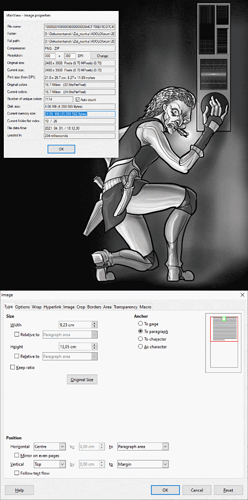Nothing new in the edit, I just fix typos and misspellings.
I have no stray blank pages with 7.0.5.2. I briefly see what @Mike2 Kanganski describes about the initial page number.
However your document formatting exhibits several deficiencies.
Most important You mix styling and direct formatting. You have not thoroughly thought about your styles: the same style is frequently applied onto paragraphs which do not cover the same abstract topic. This is compensated for with direct formatting to slightly change the appearance.
Absolutely no character style is used. Every intra-paragraph variation is applied manually.
No frame style is used to standardize the frame appearance/placement.
Outline
You didn’t use the Header n family. This is a perfectly legitimate decision but it must be consistent. You replaced Header 1 with !E4F_Title_L1 in Tools>Chapter Numbering but none of the others. You left !E4F_Title_L2, !E4F-section_start and !E4F-subsection_start out of it.
In the text, frequently outline level 3 headings are missing: you have the sequence 1-2-4. This is probably a decision of yours related to what should be inserted in the TOC.
You have erroneously styled the TOC title !E4F_Title_L1 in the TOC configuration which certainly disturbs TOC generation because the TOC title is required to be in the TOC itself at level 1while the TOC does not exist yet. You are creating a conflict. Customize Contents Heading itself without assigning it an outline level.
Similarly, some table captions (manually added while others are made with Insert>Caption) are styled !E4F-subsection_start. You don’t see it because you limit your TOC to level 3, but this is wrong.
You even have an empty paragraph as !E4F_Title_L1 (the one on the first page). You are lucky. Writer apparently suppresses empty paragraphs from TOC collection.
You didn’t use the Contents n family for the TOC.
Note that built-in styles can be customized at will. This avoids to redo the full configuration and forget some parameters. This is exemplified by your partial Tools>Numbering reconfiguration even if you don’t number your headings.
Structure
It is uselessly complex. It seems you lose track of what you’ve done.
Your sections (which are justified because you want to have headings on full width and text in 2-column) are nested up to 3 levels.
Taking the example of the very first sections: Section56 (2-column) is nested in Section6 which has no other content than Section56. Section6 could be removed altogether: it does not change the formatting but simplifies the structure which is beneficial for stability.
The same goes for Section4 which has dozens of nested sections. And so on …
Remember that the lighter the structure, the better the performance and reliability.
Similarly, numerous tables (those with a single column) could be replaced by an adequate style with the required border. Writer can merge borders of consecutive paragraphs of same style. This could avoid possible weird table splits and associated formatting issues.
Nearly all your page breaks are manual. Most could be transferred into the style Text Flow tab, e.g. !E4F_Title_L1. But you are not consistent about your level 2. This could be fixed with a Keep with next paragraph setting and a larger spacing above and below.
##Randomly inserted blank page
After playing with your file and testing structure simplication, I cause a blank page to appear between pages 21 and 22 (but this may not be the same as yours because I have not the same fonts and I already modified a bit the structure).
From my experience, this is a common “glitch” caused by interactions between sections and tables in complex structure documents (and yours is really uselessly complex).
The “culprit” is the “Object Durability” table. You allowed the table and its rows to split across pages and columns. It got the heading row at the bottom of a page, a blank page and table content at start of next page, followed by the rest of the document.
It appears this table has a semantic heading row plus content rows. Table is split by text flow which cuts it anywhere. If you request to repeat the heading row, text flow is informed about the table semantics and the table heading is shifted on next page instead of being left alone. The remaining space of the preceding page is roughly one line which is usual.
It would seem silly to request heading repetition on such small tables but you never know what text flow will do. Therefore give it maximum information about your tables so that it can react accordingly.
I think that configuring all your tables like this will fix the majority of your spurious blank pages.
##Summary
On such a long document, avoid direct formatting. Style your document (not only paragraph styles but also character, frame and pages – I didn’t check your page styles)
Review your paragraph style collection to make it more consistent and more specific: one semantic meaning => one paragraph style; don’t use the same for different significances, you’ll want to fix with direct formatting (and this always causes problems).
Simplify your section nestings.
Add heading information in your table properties.
To show the community your question has been answered, click the ✓ next to the correct answer, and “upvote” by clicking on the ^ arrow of any helpful answers. These are the mechanisms for communicating the quality of the Q&A on this site. Thanks!
In case you need clarification, edit your question (not an answer which is reserved for solutions) or comment the relevant answer.
 but LO doesn’t seem to consume too much of the system resources at any given time based on the task manager, even when i have it running for a week.
but LO doesn’t seem to consume too much of the system resources at any given time based on the task manager, even when i have it running for a week.
